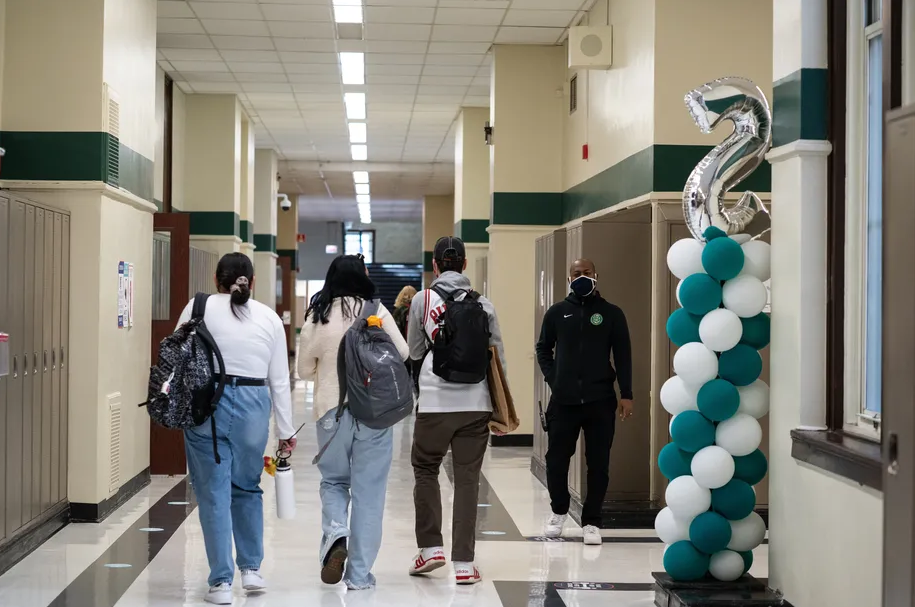Chicago previews plan to reconnect with missing students
Chicago will step up home visits, cultivate an in-house tutoring corps, and grow summer job opportunities to try to reconnect with tens of thousands of students who largely tuned out school during the pandemic.
Chicago officials, including its interim CEO José Torres, have said tracking down and reengaging students who went missing during the pandemic or only took part in learning intermittently is a top priority — an essential part of any pandemic recovery effort.
The district has not offered an estimate for how many students have completely or partially disengaged from learning. But at a Wednesday board meeting, officials said about 84,500 students have been flagged for targeted support, including stepped-up efforts to reach their families over the phone this summer. Another 18,130 students will qualify for the most intensive outreach and what officials described as “relentless reengagement interventions.” Chicago enrolled about 341,000 students at the start of the school year.
The district said it is zeroing in on parts of the city hardest hit by the coronavirus disruption, based on a new Student Prioritization Index, a tool to steer more support to students whose attendance, grades, and mental health have suffered the greatest toll.
“We’ll be focusing our greatest efforts on the South Side and the West Side while continuing to ensure students in every neighborhood get the support they need,” Michael Deuser, the district’s chief of college and career success, told the school board Wednesday.
The reengagement efforts are part of a broader $525 million “Moving Forward Together” plan to address the academic and mental health damage from the pandemic. The two-year effort, which district leaders unveiled last week, will be funded with a portion of $1.8 billion in federal dollars earmarked for school coronavirus recovery.
The district will use another data tool, the Unfinished Learning School Investment Index — based on metrics including student race, family income, COVID rates this past spring in a school’s zip code, and student mobility rates — “to ensure that students in schools that need more will get more,” the district’s outgoing CEO Janice Jackson said Wednesday.
“In keeping with our district’s commitment to equity,” Jackson said, “we have prioritized the students who we believe need it most to receive the additional federal stimulus funds.”
The plan includes $160 million in flexible funds that school leaders can tailor to their campus needs in consultation with school communities. It will also invest $165 million in districtwide academic and social-emotional supports as well as $201 million in resources targeted to priority student groups, such as special education students and English learners.
Under the “Moving Forward Together” plan, districtwide funds will pay for efforts to start behavior and mental health teams at each school and partner with outside groups to provide mental health services. They will also go toward math and reading interventions, classroom technology, and a new Work-Based Learning Center, which will help students plan for careers after graduation. These funds will also pay for efforts to reengage students and families, including partnerships with community-based organizations to help with outreach.
“Arguably, reengagement is the single most important task we have ahead of us as we welcome students back to school after such a challenging year,” Deuser told the school board during a special meeting on the plan last week. “That’s why it will remain a priority for us, not just over the summer and the beginning of the school year, but all year long and beyond.”
The targeted student supports will include:
- a new CPS Tutor Corps, an initiative to hire and train 850 staffers to provide intensive one-on-one tutoring in math and reading
- new early literacy supports, including professional development for teachers, classroom libraries, and more
- a new pool of mentors and mental health providers
- student job opportunities
- additional school counselors
- added supports for students with special needs and English learners
District officials said they will reach out to educators, families, and others in January to size up the impact of the “Moving Forward Together” investments. They vowed to update that plan based on their feedback, in keeping with a federal requirement for “meaningful public engagement” in spending the stimulus funds.
The district is also hosting two virtual town halls on the plan, at 5:30 p.m. on Monday and Wednesday.
This article was originally posted on Chicago previews plan to reconnect with missing students


